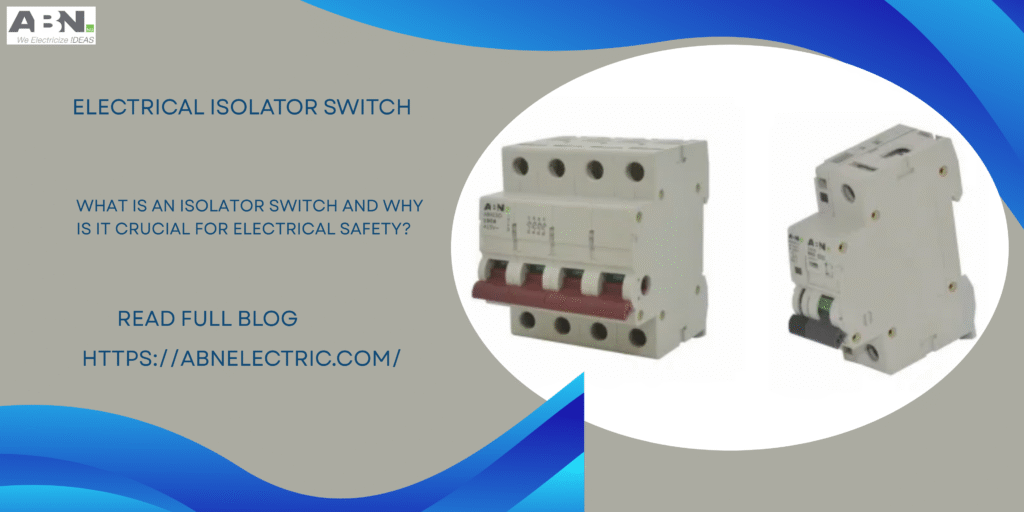Electrical safety remains one of the most critical aspects of any building’s infrastructure. Among the various components that ensure our electrical systems operate safely, the isolator switch stands as a fundamental guardian of electrical circuits. But what exactly is an isolator switch, and why should you care about this seemingly simple device?
An isolator switch is a mechanical switching device that provides a visible break in an electrical circuit, ensuring complete isolation of electrical equipment from the power supply. Unlike other switching devices, isolators are designed to be operated only when no current is flowing through the circuit, making them essential for maintenance work and emergency situations.
This comprehensive guide will explore everything you need to know about isolator switches, from their basic functionality to their crucial role in electrical safety protocols. You’ll learn about different types of isolators, their applications, and why they’re indispensable in both residential and commercial electrical systems.
Understanding the Fundamentals of Isolator Switches
An isolator switch serves one primary purpose: to create a safe, visible gap in an electrical circuit when maintenance or repair work is required. These devices are specifically designed to operate under no-load conditions, meaning they should only be switched when no current flows through the circuit.
The fundamental principle behind isolator switches is simple yet effective. When activated, the isolator creates a physical separation between the power source and the electrical equipment downstream. This visible break ensures that technicians can safely work on electrical systems without the risk of electrocution or accidental energization.
Isolator switches differ significantly from other switching devices like circuit breakers or contactors. While circuit breakers can interrupt fault currents and contactors can switch loads under normal operating conditions, isolators are purely safety devices. They provide mechanical isolation rather than electrical protection.
The construction of an isolator switch typically includes robust contacts, an operating mechanism, and a clear visual indication of the switch position. Most isolators feature a handle or lever that clearly shows whether the switch is in the “ON” or “OFF” position, eliminating any guesswork about the circuit’s status.
Types of Isolator Switches and Their Applications
Isolator switches come in various configurations to meet different electrical system requirements. Understanding these types helps in selecting the appropriate isolator for specific applications.
Single-Pole Isolators
Single-pole isolators, often designated as 1P, are the simplest form of isolator switches. These devices isolate one phase of an electrical circuit and are commonly used in single-phase residential applications. They’re particularly useful for isolating individual circuits or equipment pieces that don’t require complex switching arrangements.
Multi-Pole Isolators
Multi-pole isolators include two-pole (2P), three-pole (3P), and four-pole (4P) configurations. Three-pole isolators are standard in three-phase industrial applications, while four-pole isolators provide isolation for three-phase systems with a neutral conductor. These configurations ensure simultaneous disconnection of all relevant conductors.
Some isolators also come in 1P+N and 3P+N configurations, where the neutral conductor is switched along with the phase conductors. This arrangement is particularly important in systems where the neutral carries current or where complete isolation is required for safety reasons.
Load Break Isolators
While traditional isolators operate under no-load conditions, load break isolators can safely interrupt normal load currents. These specialized devices combine the isolation function with limited switching capability, making them suitable for applications where occasional load switching is required.
The Critical Role of Isolator Switches in Electrical Safety
Electrical safety protocols mandate the use of isolator switches in numerous applications. These devices serve as the first line of defense against electrical accidents during maintenance and repair work.
Lockout/Tagout Procedures
Isolator switches play a vital role in lockout/tagout (LOTO) procedures. These safety protocols require the physical isolation of energy sources before maintenance work begins. The isolator switch provides the necessary visible break in the circuit, and its operating handle can be locked in the “OFF” position to prevent accidental energization.
The visual indication provided by isolator switches is crucial for LOTO procedures. Maintenance personnel can quickly verify that the circuit is isolated without relying on electrical measurements or indicators that might fail. This visible confirmation adds an extra layer of safety to maintenance operations.
Emergency Disconnection
Isolator switches provide a reliable means of emergency disconnection when electrical equipment malfunctions or poses a safety risk. Unlike electronic switching devices that might fail during emergencies, mechanical isolators offer dependable operation even under adverse conditions.
The robust construction of isolator switches ensures they can operate effectively even after extended periods of inactivity. This reliability is essential for emergency applications where the switch might remain in the “ON” position for months or years before being needed.
Protection During Maintenance
Electrical maintenance work requires absolute certainty that circuits are de-energized. Isolator switches provide this certainty through their mechanical operation and visible indication. Technicians can see exactly which circuits are isolated and have confidence in the safety of their work environment.
Integration with Circuit Protection Systems
Modern electrical systems often integrate isolator switches with other protection devices to create comprehensive safety solutions. Miniature circuit breakers (MCBs) with integrated isolators exemplify this approach.
MCB-Isolator Combinations
MCBs with isolator functionality combine overcurrent protection with isolation capability. These devices protect against both overload and short circuit conditions while providing the isolation function required for maintenance work. This integration reduces panel space requirements and simplifies electrical system design.
The combination of protection and isolation in a single device offers several advantages. It reduces the number of components in electrical panels, simplifies wiring, and ensures that protection and isolation functions work together seamlessly. These combination devices are available in various ratings, from 0.5A to 125A, to accommodate different application requirements.
Busbar Connection Systems
Professional-grade isolator switches often feature pin-fork type busbar terminal connections. These connections provide reliable electrical contact and make installation more straightforward. The busbar connection system also allows for easy maintenance and replacement of isolator switches without disturbing adjacent components.
The mechanical design of busbar connections ensures consistent contact pressure and reduces the risk of connection failure. This reliability is crucial for isolator switches, which must maintain their mechanical integrity over extended periods of operation.
Installation and Mounting Considerations
Proper installation of isolator switches is essential for their effective operation and safety. Most isolators are designed for standard DIN rail mounting, which simplifies installation and ensures consistent positioning.
DIN Rail Mounting
The 35mm DIN rail mounting system provides a standardized method for installing isolator switches in electrical panels. This mounting system ensures proper alignment and spacing while allowing for easy removal and replacement when necessary.
DIN rail mounting also facilitates the use of auxiliary components such as auxiliary contacts and shunt releases. These add-on devices extend the functionality of isolator switches and enable integration with control systems and monitoring equipment.
Screw Mounting Options
Some isolator switches also offer screw mounting options for applications where DIN rail mounting is not suitable. This flexibility allows for installation in custom panels or retrofit applications where existing mounting arrangements must be accommodated.
Regulatory Compliance and Standards
Isolator switches must comply with various electrical standards and regulations. Understanding these requirements is crucial for proper selection and installation.
UL Certification
UL (Underwriters Laboratories) certification ensures that isolator switches meet stringent safety and performance standards. UL-certified isolators undergo rigorous testing to verify their electrical, mechanical, and thermal performance under various operating conditions.
The availability of both UL-certified and non-UL variants allows for flexibility in meeting different regulatory requirements. UL certification is particularly important for applications in North America, where it’s often a mandatory requirement for electrical equipment.
International Standards
Isolator switches must also comply with international standards such as IEC (International Electrotechnical Commission) standards. These standards ensure global compatibility and safety compliance across different markets and applications.
Maintenance and Testing of Isolator Switches
Regular maintenance and testing of isolator switches ensure their continued reliability and safety. These devices require periodic inspection and verification of their mechanical and electrical performance.
Visual Inspection
Regular visual inspection of isolator switches should include checking for signs of damage, wear, or contamination. The operating mechanism should move freely and provide clear indication of the switch position. Any signs of arcing, overheating, or mechanical damage require immediate attention.
Mechanical Operation Testing
The mechanical operation of isolator switches should be tested periodically to ensure smooth operation and proper contact engagement. This testing should be performed with the circuit de-energized and following proper safety procedures.
Electrical Testing
Electrical testing of isolator switches includes verification of contact resistance and insulation resistance. These tests ensure that the switch provides proper electrical connection when closed and adequate isolation when open.
Selecting the Right Isolator Switch for Your Application
Choosing the appropriate isolator switch requires consideration of several factors, including electrical ratings, environmental conditions, and regulatory requirements.
Electrical Ratings
The electrical rating of an isolator switch must match or exceed the requirements of the circuit it will control. This includes considerations of voltage rating, current rating, and short-circuit capacity. For example, standard isolators might handle 6kA short-circuit current for ratings up to 63A, while higher-rated devices might handle 10kA.
Environmental Factors
Environmental conditions such as temperature, humidity, and contamination levels affect isolator switch selection. Switches installed in harsh environments require appropriate protection ratings and materials to ensure reliable operation.
Regulatory Requirements
Regulatory requirements vary by location and application. Understanding these requirements early in the selection process ensures compliance and avoids costly modifications later.
Future Trends in Isolator Switch Technology
The electrical industry continues to evolve, and isolator switch technology advances to meet new challenges and requirements.
Smart Isolators
Smart isolator switches incorporate electronic monitoring and communication capabilities. These devices can provide remote status indication, operation counting, and condition monitoring. Smart isolators enable predictive maintenance and improve system reliability.
Enhanced Safety Features
New safety features in isolator switches include improved arc suppression, enhanced mechanical interlocks, and better environmental protection. These features reduce maintenance requirements and improve overall system safety.
Ensuring Long-Term Electrical Safety
Electrical isolator switch represent a critical component in electrical safety systems, providing the mechanical isolation necessary for safe maintenance and operation of electrical equipment. Their simple yet effective design ensures reliable operation even after extended periods of inactivity.
The importance of proper isolator switch selection, installation, and maintenance cannot be overstated. These devices serve as the foundation of electrical safety protocols, protecting both personnel and equipment from electrical hazards.
As electrical systems become more complex and demanding, the role of isolator switches becomes even more critical. Understanding their function, applications, and limitations ensures that these essential safety devices continue to protect electrical systems effectively.
Whether you’re designing a new electrical system or maintaining an existing one, remember that isolator switches are not optional safety devices—they’re essential components that can mean the difference between a safe work environment and a potentially dangerous one.

